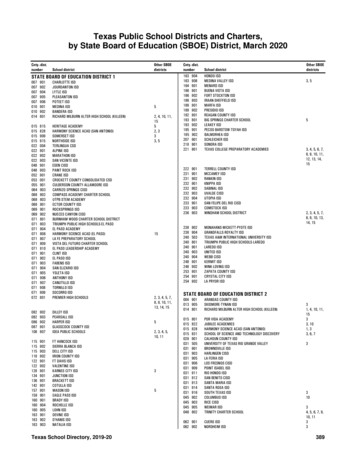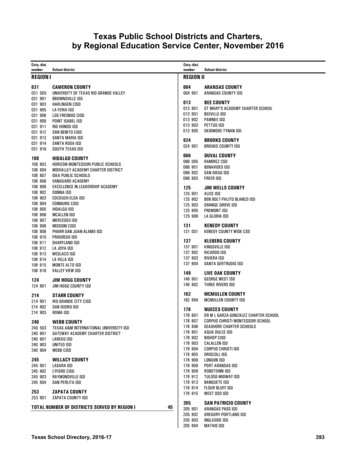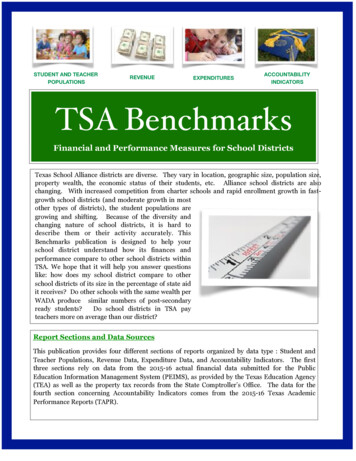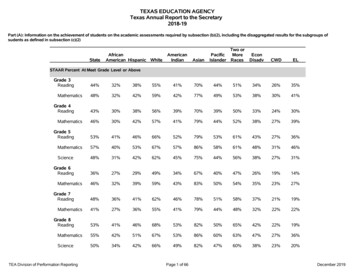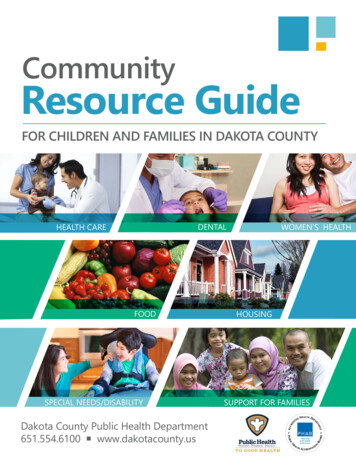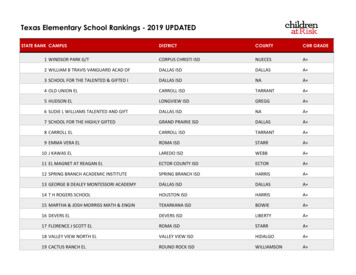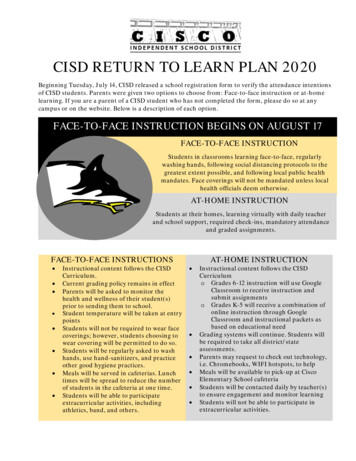
Transcription
CISD RETURN TO LEARN PLAN 2020Beginning Tuesday, July 14, CISD released a school registration form to verify the attendance intentionsof CISD students. Parents were given two options to choose from: Face-to-face instruction or at-homelearning. If you are a parent of a CISD student who has not completed the form, please do so at anycampus or on the website. Below is a description of each option.FACE-TO-FACE INSTRUCTION BEGINS ON AUGUST 17FACE-TO-FACE INSTRUCTIONStudents in classrooms learning face-to-face, regularlywashing hands, following social distancing protocols to thegreatest extent possible, and following local public healthmandates. Face coverings will not be mandated unless localhealth officials deem otherwise.AT-HOME INSTRUCTIONStudents at their homes, learning virtually with daily teacherand school support, required check-ins, mandatory attendanceand graded assignments.FACE-TO-FACE INSTRUCTIONS Instructional content follows the CISDCurriculum.Current grading policy remains in effectParents will be asked to monitor thehealth and wellness of their student(s)prior to sending them to school.Student temperature will be taken at entrypointsStudents will not be required to wear facecoverings; however, students choosing towear covering will be permitted to do so.Students will be regularly asked to washhands, use hand-sanitizers, and practiceother good hygiene practices.Meals will be served in cafeterias. Lunchtimes will be spread to reduce the numberof students in the cafeteria at one time.Students will be able to participateextracurricular activities, includingathletics, band, and others.AT-HOME INSTRUCTION Instructional content follows the CISDCurriculumo Grades 6-12 instruction will use GoogleClassroom to receive instruction andsubmit assignmentso Grades K-5 will receive a combination ofonline instruction through GoogleClassroom and instructional packets asbased on educational needGrading systems will continue. Students willbe required to take all district/stateassessments.Parents may request to check out technology,i.e. Chromebooks, WIFI hotspots, to helpMeals will be available to pick-up at CiscoElementary School cafeteriaStudents will be contacted daily by teacher(s)to ensure engagement and monitor learningStudents will not be able to participate inextracurricular activities.
Cisco ISD COVID-19 Response ManualI.II.III.IV.Texas Education Agency Public Health Planning & GuidanceDocumentDistrict Instructional Practicesa. Face-to-Faceb. AsynchronousSafety Precautionsa. Temperatureb. Visitorsc. Staffd. Cafeteriai. Elementaryii. Secondarye. Transportationf. CleaningCISD COVID-19 Standard Response Protocol
SY 20‐21 Public HealthPlanning GuidanceJuly 17, 2020This guidance document is being provided based on the public health situation as we understand ittoday and takes effect immediately, both for summer school instruction ending the 2019‐2020 schoolyear and to help support school systems in planning for the 2020‐2021 school year, regardless ofwhether a school system starts at the date currently planned or the local school board votes to changethe school system’s calendar to delay the start of the school year. Changes to the public healthsituation over the course of the summer may necessitate changes to this guidance.This guidance addresses:‐ On campus and virtual instruction‐ Administrative activities by teachers, staff, or students that occur on school campuses or‐‐‐virtuallyNon-UIL extracurricular sports and activitiesAny other activities that teachers, staff, or students must complete that cannot be accomplishedvirtuallyVisits by parents and the general publicIt is recommended that after‐school providers and other programs that operate in conjunction withcampuses follow this guidance in coordination with the campus(es) they serve.Public Health ConsiderationsThe virus that causes COVID‐19 can infect people of all ages, and school system leaders should doeverything feasible to keep students, teachers, staff, and our communities safe. That said, researchfrom the Centers for Disease Control (CDC), among others, has found that while children do getinfected by COVID‐19 and some severe outcomes have been reported in children, relatively fewchildren with COVID‐19 are hospitalized or have severe symptoms. Furthermore, the AmericanAcademy of Pediatrics notes that COVID‐19 risks must be balanced with the need for children to attendschool in person, given that lack of physical access to school leads to a number of negativeconsequences, placing “children and adolescents at considerable risk of morbidity, and in some case,mortality.iWhile it is not possible to eliminate all risk of furthering the spread of COVID‐19, the current sciencesuggests there are many steps schools can take to reduce the risks to students, teachers, staff, andtheir families significantly. This guidance document contains information on four sets of practices thatminimize the likelihood of viral spread, including some that are requirements for all schools and othersthat are recommendations:ii PROVIDE NOTICE: Requirements for parental and public notices PREVENT: Required practices to prevent the virus from entering the school RESPOND: Required practices to respond to a lab-confirmed case in the school
MITIGATE: Recommended and required practices to reduce likely spread inside the schoolThe prevention and mitigation practices outlined in this document are designed to significantly reducethe likelihood that a coronavirus outbreak occurs on campus. Some practices are required for all schoolsystems, some are required in areas with high levels of community spread, and some arerecommendations. Consistently implementing recommendations to the extent feasible is the best wayto reduce the potential negative impact of infection on students’ educational experiences.Additionally, systems should consider stringently applying recommended practices to adults oncampuses, even when it might not be feasible to do so for students, to more fully protect adultteachers and staff who are generally at greater risk from COVID‐19 than students.There will almost certainly be situations that necessitate temporary school closure due to positiveCOVID‐19 cases in schools. Parents, educators, and school administrators should be prepared for this inthe event that it occurs, while actively working to prevent it through prevention and mitigationpractices.PROVIDE NOTICE: Parental and Public NoticesDeveloping a Plan for On-Campus Activities and InstructionSchool systems must post for parents and the general public, one week prior to the start of on‐ campusactivities and instruction, a summary of the plan they will follow to mitigate COVID‐19 spread in theirschools based on the requirements and recommendations outlined here. This summary document canfollow any format the school system deems appropriate to communicate the information, shouldbroadly address the major points in this guidance, and must be posted on the school system homepageor another easily found area on the system website. The document should be developed inconsultation with teachers, staff, and parents to ensure the plan provides for the safety of teachers,staff, and students. Neither this summary document nor any local school systems’ reopening plans aresubject to approval by any government entity.It is recommended that, within this summary, school systems designate a staff person or group that isresponsible for responding to COVID‐19 concerns and clearly communicate for all school staff andfamilies who this person or group is and how to contact them.Attendance and Enrollment1. Per Texas Education Code (TEC), §25.092, students must attend 90% of the days a course isoffered (with some exceptions) in order to be awarded credit for the course and/or to bepromoted to the next grade. This requirement remains in force during the 2020-21 school year.2. Given the public health situation, student attendance may be earned through the delivery ofvirtual instruction.3. Any parent may request that their student be offered virtual instruction from any school systemthat offers such instruction. If a parent who chooses virtual instruction wants their child toswitch to an on-campus instructional setting, they can do so, but school systems are
permitted to limit these transitions to occur only at the end of a grading period, if it will be beneficial tothe student’s instructional quality. If a parent requests virtual instruction and the school does not offerit, the parent may enroll in another school that does offer it for transfer students.4. School systems must provide on-campus attendance as an option for students otherwiseentitled to attend school who follow this document’s required public health procedures andwhose parents wish them to attend on campus, subject to school closure and the exceptionslisted in this document. In high school, school systems may offer a less than daily on campusinstructional experience if there is a need to reduce the total count of people on campus at anyone time to maintain social distancing.5. In order to facilitate an safe, effective back-to-school transition process, during a period up tothe first four weeks of school, which can be extended by an additional four weeks by vote of theschool board, school systems may temporarily limit access to on-campus instruction. As aresult, some parents opting for their student(s) to attend on campus may be required to startwith remote instruction temporarily, although any family who does not have Internet accessand/or devices for distance learning at home is still entitled to have their student receive oncampus instruction each day during this transition period, as they are during the rest of theyear. School systems must clearly describe this transition process in their posted summary oftheir plans to operate campuses safely, as required above.6. School systems are required to provide parents a notice of their public education enrollmentand attendance rights and responsibilities during the COVID-19 pandemic using a documentpublished by TEA.PREVENT: Practices to Prevent the Virus from Entering the SchoolScreening Questions for COVID-19 Before Campus Access1. School systems must require teachers and staff to self-screen for COVID-19 symptoms beforecoming onto campus each day. Symptoms are listed at the end of this document. The selfscreening should include teachers and staff taking their own temperature. Teachers and staffmust report to the school system if they themselves have COVID-19 symptoms or are labconfirmed with COVID-19, and, if so, they must remain off campus until they meet the criteriafor re-entry as noted below. Additionally, they must report to the school system if they have hadclose contact with an individual who is lab-confirmed with COVID-19, as defined at the end ofthis document, and, if so, must remain off campus until the 14-day incubation period haspassed.2.Parents must ensure they do not send a child to school on campus if the child hasCOVID-19 symptoms (as listed in this document) or is lab-confirmed with COVID-19, andinstead should opt to receive remote instruction until the below conditions for re-entry are met.Parents may also opt to have their students receive remote instruction if their child has hadclose contact with an individual who is lab-confirmed with COVID-19 until the 14-dayincubation period has passed. School systems may consider screening students for COVID-19as well. Screening is accomplished by asking questions by phone or other electronic methodsand/or in person. The screening questions should also be asked of a student’s parent if thatparent will be dropping off or picking up their child from inside the school. Regularlyperforming a forehead temperature check of otherwise asymptomatic students in school is notrecommended, but the practice is also not prohibited by this guidance.3. Excluding parental drop-off and pick-up as discussed above, before visitors are allowed ontocampuses, school systems must screen all visitors to determine if the visitors have COVID-19
symptoms (as listed in this document) or are lab-confirmed with COVID-19, and, if so, theymust remain off campus until they meet the criteria for re-entry as noted below. Additionally,school systems must screen to determine if visitors have had close contact with an individualwho is lab-confirmed with COVID-19, and, if so, they must remain off campus until the 14-dayincubation period has passed. When practical, screening questions could be supplemented withtemperature checks of adults.Individuals Confirmed or Suspected with COVID-191. Any individuals who themselves either: (a) are lab-confirmed to have COVID-19; or (b)experience the symptoms of COVID-19 (listed below) must stay at home throughout theinfection period, and cannot return to campus until the school system screens the individual todetermine any of the below conditions for campus re-entry have been met:o In the case of an individual who was diagnosed with COVID‐19, the individual mayreturn to school when all three of the following criteria are met:i. at least three days (72 hours) have passed since recovery (resolution of feverwithout the use of fever-reducing medications);ii. the individual has improvement in symptoms (e.g., cough, shortness of breath);iii. at least ten days have passed since symptoms first appeared.o In the case of an individual who has symptoms that could be COVID-19 and who is notevaluated by a medical professional or tested for COVID-19, such individual is assumedto have COVID-19, and the individual may not return to the campus until the individualhas completed the same three-step set of criteria listed above.o If the individual has symptoms that could be COVID-19 and wants to return to schoolbefore completing the above stay at home period, the individual must either (a) obtain amedical professional’s note clearing the individual for return based on an alternativediagnosis or (b) receive two separate confirmations at least 24 hours apart that they arefree of COVID via acute infection tests at an approved COVID-19 testing location foundat https://tdem.texas.gov/covid-19/.Identifying Possible COVID-19 Cases on Campuso Schools must immediately separate any student who shows COVID-19 symptoms while atschool until the student can be picked up by a parent or guardian.o Schools should clean the areas used by the individual who shows COVID-19 symptoms while atschool (student, teacher, or staff) as soon as is feasible.o Students who report feeling feverish should be given an immediate temperature check todetermine if they are symptomatic for COVID-19.RESPOND: Practices to Respond to a Lab‐Confirmed Case in the SchoolRequired Actions if Individuals with Lab-Confirmed Cases Have Been in a School1. If an individual who has been in a school is lab-confirmed to have COVID-19, the school mustnotify its local health department, in accordance with applicable federal, state and local lawsand regulations, including confidentiality requirements of the Americans with Disabilities Act(ADA) and Family Educational Rights and Privacy Act (FERPA).
2. Schools must close off areas that are heavily used by the individual with the lab-confirmed case(student, teacher, or staff) until the non-porous surfaces in those areas can be disinfected,unless more than 3 days have already passed since that person was on campus.3. Consistent with school notification requirements for other communicable diseases, andconsistent with legal confidentiality requirements, schools must notify all teachers, staff, andfamilies of all students in a school if a lab-confirmed COVID-19 case is identified amongstudents, teachers or staff who participate on any on campus activities.MITIGATE: Practices to Mitigate the Likelihood of COVID‐19 Spread Inside the SchoolOperational Considerations:Health and Hygiene Practices: General1. Schools should attempt to have hand sanitizer and/or hand washing stations with soap andwater at each entrance. They should also attempt to provide hand sanitizer and/or handwashing stations with soap and water in every classroom.2. Students, teachers, staff, and campus visitors should be encouraged to sanitize and/or washhands frequently.o School systems are encouraged to have students engage in supervised handwashing forat least 20 seconds at least two times each day, in addition to being encouraged to washhands after using the restroom and before eating.o School systems are encouraged to teach students good handwashing techniques.o Students, teachers, staff, and campus visitors should be encouraged to cover coughs andsneezes with a tissue, and if not available, covered in their elbows. Used tissues shouldbe thrown in the trash, hands should be washed immediately with soap and water for atleast 20 seconds, or hand sanitizer should be used.3. Campuses should institute more frequent cleaning practices, including additional cleaning byjanitorial staff, as well as provide the opportunity for children to clean their own spaces beforeand after they are used, in ways that are safe and developmentally appropriate.o Schools should arrange for additional cleaning and disinfecting of surfaces that aretouched in common throughout the day. This would include objects such as doorhandles, common tables/desks, shared supplies such as art supplies, and high touchdevices such as shared laptops or tablets.o Schools should arrange for cleaning of commonly-touched surfaces in classroomsbetween different class groups, if the same room will be used by multiple class groups.o The CDC has provided guidance on cleaning community buildings to prevent COVID-19spread.o Schools should ensure these products are stored safely, including storing harmfulproducts where children cannot access them, and ensuring that harmful cleaningproducts are not used near children.
4. Whenever possible, schools should open windows or otherwise work to improve air flow byallowing outside air to circulate in the building.5. If a building has remained dormant for an extended period, we recommend you reviewCDC guidance on maintaining water system safety when buildings are unused forextended periods of time, and apply this guidance as appropriate.6. The CDC provides a range of printed resources such as posters that promote protectivemeasures and can serve as helpful reminders of best practices. Schools may use these or maycreate their own reminders.7. On the first day a student attends school on campus, school systems must provide instruction tostudents on appropriate hygiene practices and other mitigation practices adopted in the localschool system.Health and Hygiene Practices: Masks1. For the purposes of this document, masks include non-medical grade disposable face masks,cloth face coverings (over the nose and mouth), or full-face shields to protect eyes, nose, andmouth. Face shields may be superior to cloth face coverings in many circumstances, givenimproved ability to see mouth movements and improved air circulation.2. Schools are required to comply with the governor’s executive order regarding the wearing ofmasks.3. In addition to the executive order, school systems may require the use of masks or face shieldsfor adults or students for whom it is developmentally appropriate.4. It may be impractical for students to wear masks or face shields while participating in somenon-UIL athletic or other extracurricular activities. When it is impractical for students to wearmasks or face shields during those activities, schools must require students, teachers, staff, andvisitors to wear masks or face shields when entering and exiting facilities and practice areas andwhen not actively engaging in those activities. Schools may, for example, allow students whoare actively exercising to remove masks or face shields, as long as they maintain at least six feetof distance from other students, teachers, and staff who are not wearing masks or face shields.However, schools must require students, teachers, and staff to wear masks or face shields asthey arrange themselves in positions that will allow them to maintain safe distancing.Student-Teacher GroupingsWhere feasible without disrupting the educational experience, encourage students to practice socialdistancing.1. In classroom spaces that allow it, consider placing student desks a minimum of six feet apartwhen possible.2. In classrooms where students are regularly within six feet of one another, schools should planfor more frequent hand washing and/or hand sanitizing and should consider whether increasedairflow from the outdoors is possible.Use of Non-Classroom Spaces1. When feasible and appropriate (for example, in physical education classes as weather permits),it is preferable for students to gather outside, rather than inside, because of likely reduced riskof virus spread outdoors.
2. Schools may continue to offer extracurricular activities, at their discretion and consistent with3.4.5.6.7.the guidance in this document, for non-UIL extracurricular activities and with the guidancefound on the UIL website for all UIL activities.As is the case in typical years, school systems with policies that allow it may open facilities tothe public. Operation of the facilities should be done consistent with the governor’s executiveorders for similar activities.Campuses must plan for entry, exit, and transition procedures that reduce large groupgatherings (of students and/or adults) in close proximity. Consider staggering school start andend times, assigning students to entries to ensure even distribution of studentsentering/exiting at each door, providing guidance to students to enter one at a time and waitsix feet apart outside the entrance, and, where appropriate, encouraging parents to remainoutside during drop-off and pick-up.Depending upon local conditions, school systems should consider eliminating assemblies andother activities that bring large groupings of students and/or teachers and staff together.Consider adding dividers between bathroom sinks, especially when students cannot be at leastsix feet apart while using the sinks.School systems should consider practices that reduce the likelihood that students meet theclose contact definition (defined below) at lunch. This could include having students eat lunchat their desks. It could include the use of seats that are spaced at least 6 feet apart. It couldinclude the use of dividers on cafeteria tables if they can serve the purpose of shielding thestudents from respiratory droplets with which they might otherwise come into contact. Formeal service itself, consider individually plated meals with disposable food service items forstudents who do not bring their own lunch.Transportation Recommendations1. School systems should consider requiring students and staff to use hand sanitizer uponboarding the bus.2. When possible, schools should open windows to allow outside air to circulate in the bus.3. School systems should encourage families to drop students off, carpool, or walk with theirstudent to school to reduce possible virus exposure on buses.4. Buses should be thoroughly cleaned after each bus trip, focusing on high-touch surfaces such asbus seats, steering wheels, knobs, and door handles. During cleaning, open windows to allowfor additional ventilation and air flow.Visits to Schoolso Parents and other adults can visit schools, as permitted by local school system policies. Duringthese visits, parents and other visitors must follow virus prevention and mitigationrequirements of the school.o Schools systems should restrict visits in schools to only those essential to school operations.Staffing1. Employees of school systems, like employees of any organization, must continue to meet thework expectations set by their employers, subject to any applicable employment contract termsor legal requirements. However, school systems should work with teachers and other staff to
ensure the safety of students, teachers, and staff. This could include allowing those staff,including teachers, who may fulfill their work duties remotely to do so. It could includemodification of schedules to ensure, where feasible, that staff members, including teachers,interact with smaller and/or more consistent cohorts of individuals to further mitigate risk. Inaddition, teachers and staff who are in high risk categories may be entitled to paid leave underthe federal Families First Coronavirus Response Act (FFCRA) in addition to leave alreadyaccrued.2. School teachers and staff should be trained specifically on the protocols outlined in thisdocument and the practices adopted by their school system. Additionally, while not developedwith this exact guidance in mind, Texas Agri-Life Extension offers a free online course onSpecial Considerations for Infection Control During COVID-19 (2hrs). This course is intendedfor frontline childcare workers, but the principles of the course apply equally to those workingin school settings.3. School systems should attempt to reduce in-person staff meetings or other opportunities foradults to congregate in close settings. When those meetings are necessary and cannot be donevia electronic means, everyone must follow the mask protocols in this guidance, remain at least6 feet apart where feasible, consider the use of dividers, and consider whether increased airflowfrom the outdoors is possible in those settings.COVID‐19 SymptomsIn evaluating whether an individual has symptoms consistent with COVID‐19, consider the followingquestions:Have they recently begun experiencing any of the following in a way that is not normal for them?oooooooooooFeeling feverish or a measured temperature greater than or equal to 100.0 degrees FahrenheitLoss of taste or smellCoughDifficulty breathingShortness of breathHeadacheChillsSore throatShaking or exaggerated shiveringSignificant muscle pain or acheDiarrheaClose ContactThis document refers to “close contact” with an individual who is lab‐confirmed to have COVID‐19.Close contact is determined by an appropriate public health agency. For clarity, close contact is definedas:a. being directly exposed to infectious secretions (e.g., being coughed on while not wearing a maskor face shield); or
b. being within 6 feet for a cumulative duration of 15 minutes, while not wearing a mask or faceshield;if either occurred at any time in the last 14 days at the same time the infected individual wasinfectious.Individuals are presumed infectious at least two days prior to symptom onset or, in the case ofasymptomatic individuals who are lab‐confirmed with COVID‐19, two days prior to the confirming labtest.Screening Questionnaire Information1. When asking individuals if they have symptoms for COVID-19, school systems must onlyrequire the individual to provide a “Yes” or “No” to the overall statement that they aresymptomatic for COVID-19, as opposed to asking the individual for specific symptomconfirmation. School systems are not entitled to collect information during screening on thespecific health information of an individual beyond that they are symptomatic.2. Once it is determined that individuals who responded “Yes” to either of these questions havemet the criteria for re-entry, school systems must destroy those individuals’ dance/covid-19planning- hools/Within sections that primarily contain requirements, there are some recommended practices(indicated with “should”). Likewise, within sections that primarily contain recommendations, there aresome required practices (indicated with “must”).ii
II. District InstructionalPracticesDuring the initial shut downs caused by the COVID-19 virus, a significant number of statutoryrequirements of schools were waived. School districts across the state focused on providinginstructional support for students as opposed to providing instruction. This crisis response wasnecessary, but when considering the longer term of a full school year, districts are now focusing on aframework to provide instruction to students. CISD will be offering two instructional options forstudents during the 2020-2021 school year: Face-to-Face or At-Home Learning.Face-to-face is considered the "traditional" format of public education. Although certain safetyprecautions may be implemented and at times remote instruction may be included, this method willlook similar to years past. Students wishing to switch from Face-to-Face to At-home Learning will beallowed to switch as soon as can be arranged.Students choosing to utilize the At-Home Learning option will be receiving Asynchronous Instruction.Asynchronous Instruction does not require all participants to be virtually present at the same time.Students engage in the learning materials on their own time, interacting intermittently with the teachervia the computer or other electronic devices. Students selecting At-Home Learning will remain in theAt-Home Learning model through the current grading period. Students wishing to switch from AtHome Learning to Face-to-Face will be allowed to switch at the start of the next grading period.Examples of Asynchronous Instruction include: Self-paced online courses with intermittent teacherinstruction, pre-assigned work with formative assessments on paper or through a web application,watching pre-recorded videos of instruction with guided supportStudents will be required to take both state and locally developed assessments to monitor educationalachievement, i.e. State of Texas Assessment of Academic Readiness (STAAR).Asynchronous Instruction Overview In this setting, teachers will provide instruction, learning resources and support through the useof Google Classroom.Parents will support their students to ensure they have access to a device, a place to work andare engaged in virtual lear
CISD RETURN TO LEARN PLAN 2020 Beginning Tuesday, July 14, CISD released a school registration form to verify the attendance intentions of CISD students. Parents were given two options to choose from: Face-to-face instruction or at-home learning. If you are a parent of a CISD student who has not completed the form, please do so at any

